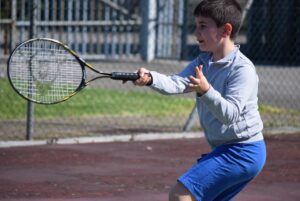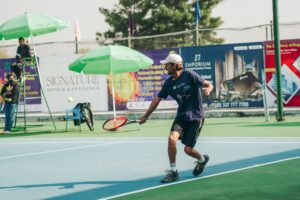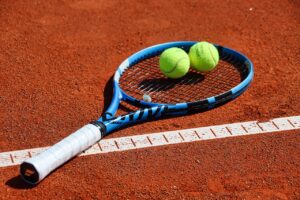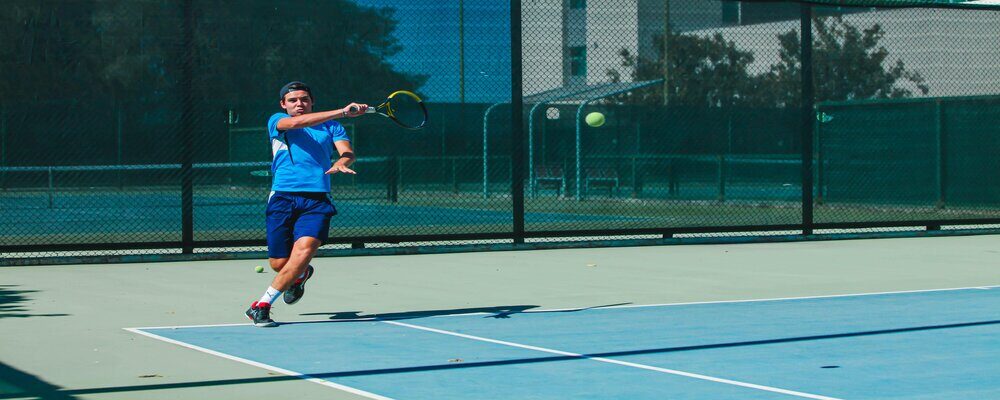Here are some more beneficial and essential facts about Junior Tennis that we must know:

1. The Benefits of Junior Tennis: Why Kids Should Play Tennis?
Engaging in this sport can have a profoundly positive impact on a child’s development. Here are some compelling reasons why kids should play tennis:
Physical Fitness and Coordination: Junior tennis is a dynamic sport that encourages kids to stay active and maintain a healthy lifestyle. It promotes cardiovascular health, muscle development, and improved hand-eye coordination. Whether they’re sprinting across the court to return a shot or using their racquet skills to place the ball precisely, tennis helps children build agility and balance, essential for all physical activities.
Social Skills and Sportsmanship: Tennis is not just about winning; it’s about respect, fairness, and good sportsmanship. Kids who play tennis learn to shake hands, follow rules, and gracefully accept both victory and defeat. This fosters valuable social skills that will serve them well throughout their lives, both on and off the court.
Goal Setting and Discipline: Junior tennis players quickly understand the importance of goal setting and discipline. To improve, they must set targets, work hard, and practice consistently. This experience instills a sense of discipline that can be applied to academic, personal, and professional pursuits.
Teamwork and Independence: While tennis is primarily an individual sport, it can also be played in doubles. Junior players can experience the value of teamwork, cooperation, and communication. Additionally, when on their own, they learn to rely on their skills and instincts, fostering independence and self-confidence.
Lifelong Enjoyment: One of the greatest benefits of junior tennis is the potential for a lifelong love for the game. Tennis is a sport that can be played well into adulthood and even in senior years. Introducing kids to tennis at a young age offers them the opportunity to enjoy a physically active, engaging, and sociable pastime throughout their lives.
Academic Benefits: Participating in tennis often leads to better time management and enhanced academic performance. The structure required for practices and matches teaches kids how to balance their time effectively, ensuring they can succeed both on the court and in the classroom.
Networking Opportunities: Tennis provides an excellent platform for networking and social interaction. Children who play tennis have the chance to meet peers from diverse backgrounds and can create lasting friendships through the sport. Additionally, tennis tournaments, events, and clubs offer opportunities to connect with mentors and influential individuals.
2. Junior Tennis Equipment: What Every Parent Needs to Know?

As a parent, it’s natural to want the best for your child, especially when they show an interest in sports like tennis. To set them up for success, it’s essential to understand what junior tennis equipment your child will need. Here’s what every parent should know:
Tennis Racquet Selection:
Size and Weight: The size and weight of the racquet should be suitable for the junior player’s age and physical strength. Junior racquets come in various lengths, typically ranging from 19 to 26 inches, with corresponding weights. Younger children should use shorter and lighter racquets to facilitate better control and maneuverability.
Grip Size: Choose a grip size that fits the junior’s hand comfortably. An incorrectly sized grip can lead to discomfort and injury. Measure the player’s hand or consult a tennis coach for guidance on the correct grip size.
String Tension: String tension can affect a junior player’s power and control. Generally, lower string tension provides more power, while higher tension offers more control. Consult with a coach to determine the ideal tension for the player’s skill level and style of play.
Racquet Composition: Junior racquets are made of various materials, including aluminum, graphite, and composite blends. Advanced junior players may benefit from graphite racquets, which offer better control and power. Novice players can start with aluminum racquets, which are more durable and budget-friendly.
Head Size: A larger head size (over 100 square inches) offers a more forgiving sweet spot, making it easier for junior players to hit the ball. However, smaller head sizes (95-100 square inches) provide more control. Choose a head size that matches the player’s skill level and preference.
Tennis Shoe Selection:
Fit and Comfort: Properly fitting tennis shoes are crucial for the comfort and safety of junior players. Ensure the shoes have ample toe room, good arch support, and a snug fit around the heel. It’s advisable to consult a shoe expert for sizing and fitting guidance.
Court Type: Tennis shoes come in various designs for different court surfaces. Choose shoes specifically designed for the type of court (hardcourt, clay, or grass) the junior player will be primarily competing on. The outsole pattern and material should match the court surface for optimal grip and performance.
Durability: Junior tennis shoes should be durable to withstand the demands of the game. Reinforced toe caps and sturdy outsoles can extend the lifespan of the shoes, especially if the player is actively training and competing.
Cushioning and Support: Look for shoes with ample cushioning in the midsole to absorb shock and provide comfort during quick movements on the court. Additionally, shoes with good lateral support can help prevent ankle injuries.
Brand and Budget: Various brands offer tennis shoes with different features and price points. Consider the budget while keeping quality and performance in mind. Reputable brands often provide reliable options.
Tennis Balls: Junior players typically use lower-compression or foam tennis balls. These balls are slower and easier to control, making it more manageable for children to learn and practice. As your child progresses, they will transition to standard tennis balls.
Clothing: Comfortable, moisture-wicking clothing is essential for tennis. Many juniors prefer athletic wear that allows for free movement. Don’t forget a hat and sunglasses for sun protection during outdoor matches.
Tennis Bag: A tennis bag will help your child keep their equipment organized and carry it to and from matches and practice. Look for a bag with multiple compartments for rackets, balls, shoes, and accessories.
Protective Gear: Depending on the level of play, your child may need protective gear, such as wristbands, headbands, or even elbow braces to prevent injuries.
Safety Precautions: Ensure your child always wears sunscreen for outdoor matches and practices. Additionally, teach them about court etiquette, sportsmanship, and safety rules.
Remember that the right equipment can greatly influence your child’s enjoyment and performance in tennis. Consult with your child’s tennis coach, other parents, and experienced players to gather recommendations and advice on equipment choices. Your child’s passion for tennis can flourish with the appropriate gear and your support.
3. Nutrition and Fitness for Junior Tennis Players
 Nutrition and fitness are crucial aspects of the development and performance of junior tennis players. Proper nutrition provides the necessary energy, nutrients, and hydration, while fitness ensures that young players have the strength, endurance, and agility required for the sport. Here’s a guide on nutrition and fitness for junior tennis players:
Nutrition and fitness are crucial aspects of the development and performance of junior tennis players. Proper nutrition provides the necessary energy, nutrients, and hydration, while fitness ensures that young players have the strength, endurance, and agility required for the sport. Here’s a guide on nutrition and fitness for junior tennis players:
Nutrition:
Balanced Diet: Junior tennis players should consume a well-balanced diet that includes carbohydrates, proteins, healthy fats, vitamins, and minerals. Carbohydrates are particularly important as they provide the energy needed for the high-intensity nature of tennis.
Hydration: Staying properly hydrated is essential. Young players should drink plenty of water throughout the day, and consume sports drinks during matches and intense training sessions to replace lost electrolytes.
Pre-match Meals: A pre-match meal should consist of easily digestible carbohydrates like whole grains, fruits, and vegetables. Avoid heavy, fatty foods that can cause digestive discomfort.
Post-match Recovery: After a match or practice, it’s important to refuel. A balanced meal or snack with carbohydrates and protein will help with muscle recovery and energy replenishment.
Snacking: Healthy snacks like fruits, nuts, yogurt, or energy bars can help maintain energy levels during long matches or training sessions.
Supplements: Consult a healthcare professional before considering supplements. In most cases, a well-balanced diet should provide all the necessary nutrients.
Fitness:
Cardiovascular Conditioning: Tennis is a physically demanding sport. Junior players should engage in cardiovascular exercises like running, swimming, or cycling to build endurance and stamina.
Strength Training: Building strength is crucial for power and preventing injuries. Young players can incorporate bodyweight exercises and resistance training with the guidance of a coach or trainer.
Agility and Speed: Tennis requires quick lateral movements and explosive speed. Agility drills, ladder exercises, and plyometric training can help improve these skills.
Core Stability: A strong core is essential for balance and control on the court. Core exercises like planks and Russian twists are beneficial.
Flexibility: Stretching and yoga can help improve flexibility and reduce the risk of injury. Flexibility is important for reaching and moving on the court.
Rest and Recovery: Adequate rest is essential for the body to recover and repair. Overtraining can lead to burnout and injury, so junior players should have scheduled rest days.
Mental Conditioning: Mental toughness is a critical aspect of tennis. Junior players should practice mental exercises and techniques to improve focus, concentration, and resilience on the court.
It’s crucial for junior tennis players to have a well-rounded approach to both nutrition and fitness. Working with qualified coaches, trainers, and healthcare professionals can help develop a customized plan that addresses the specific needs of the individual player, taking into account their age and skill level. Additionally, parental support and guidance are vital in ensuring that young athletes maintain a healthy and balanced lifestyle as they pursue their tennis goals.
4. How to Create a Practice Routine for Junior Tennis Players

Creating a practice routine for junior tennis players is essential for their development and improvement in the sport. Here’s a step-by-step guide to help you establish an effective practice routine:
Assess Skill Level: Before creating a practice routine, assess the junior player’s skill level. Understand their strengths and weaknesses to tailor the routine accordingly.
Set Goals: Establish clear, specific, and measurable goals for the player. These goals should be based on their skill level, age, and long-term aspirations.
Schedule: Determine how many days a week the player can practice and for how long. Be realistic and consider other commitments like school and rest.
Warm-Up and Cool-Down: Start each practice with a proper warm-up and finish with a cool-down routine to prevent injuries.
Technical Training: Allocate time for technical training. Focus on strokes, footwork, grips, and other fundamental skills. Ensure that the player learns and practices proper technique.
Drills: Incorporate a variety of drills to improve specific aspects of the game, such as volleys, groundstrokes, serves, and returns. Use a mix of feeding, rallying, and competitive drills.
Matchplay: Include simulated match situations or actual matches in the routine to develop tactical skills, decision-making, and mental toughness.
Fitness Training: Dedicate some time to physical fitness, including agility, strength, and endurance exercises. A well-conditioned player can move better on the court.
Mental Training: Integrate mental training techniques to help the junior player stay focused, manage stress, and maintain a positive mindset during matches.
Video Analysis: Periodically record and analyze the player’s performance. This can be a valuable tool for identifying areas that need improvement.
Rest and Recovery: Ensure there is enough time for rest and recovery. Overtraining can lead to burnout and injuries.
Consistency: Consistency is key to improvement. Encourage the junior player to stick to the routine and be patient with the progress.
Coach Involvement: If the junior player has a coach, involve the coach in the routine planning. They can provide valuable insights and guidance.
Feedback and Adjustments: Regularly assess the player’s progress and adapt the routine as needed. If certain goals are met, set new ones to keep the player motivated.
Nutrition and Hydration: Emphasize the importance of proper nutrition and hydration for optimal performance on the court.
Competition Schedule: Consider the player’s competition schedule and align the practice routine with upcoming tournaments or matches.
Parental Support: Ensure that parents and guardians are informed and supportive of the practice routine, as they play a crucial role in a junior player’s development.
Recovery Days: Include scheduled recovery days to allow the player’s body and mind to recuperate. This is important for preventing overuse injuries.
Record Keeping: Maintain a practice log or journal to track progress and adjustments made to the routine.
Long-Term Development: Keep in mind the long-term development of the player. Junior tennis players should be steadily progressing, with an eye on future opportunities.
Remember that individualization is key. Junior tennis players have unique needs, so tailor the practice routine to suit their specific goals and abilities. Additionally, seek guidance from experienced coaches and mentors to create a well-rounded and effective practice plan.
5. Junior Tennis Drills to Improve Skills and Technique
 Tennis is a sport that requires a unique combination of physical fitness, mental acuity, and technical prowess. For junior tennis players, developing fundamental skills and techniques is crucial to their growth as athletes. In this blog, we’ll explore some effective tennis drills designed specifically for young players to help them improve their skills and techniques on the court. Whether they are just starting out or looking to take their game to the next level, these drills can make a significant difference in their tennis journey.
Tennis is a sport that requires a unique combination of physical fitness, mental acuity, and technical prowess. For junior tennis players, developing fundamental skills and techniques is crucial to their growth as athletes. In this blog, we’ll explore some effective tennis drills designed specifically for young players to help them improve their skills and techniques on the court. Whether they are just starting out or looking to take their game to the next level, these drills can make a significant difference in their tennis journey.
Hand-Eye Coordination with the Wall Rally: Tennis is all about quick reactions and precise ball placement. This wall rally drill is an excellent way for junior players to develop their hand-eye coordination and overall ball control. All you need is a tennis ball, a racquet, and a sturdy wall. Here’s how it works:
– Stand about 5-6 feet away from the wall.
– Hit the ball against the wall and try to return it when it bounces back.
– Focus on maintaining a consistent rally by hitting the ball in the center of the racquet strings.
This drill not only sharpens hand-eye coordination but also encourages consistency and precision in hitting the ball.
Target Practice with Cones: One of the most critical aspects of tennis is accuracy. This drill uses cones to improve a junior player’s ability to hit specific targets on the court. Set up a row of cones on one side of the net, with each cone representing a different target. Players should aim to hit the ball to these targets consistently, forcing them to be more precise in their shots. You can gradually increase the difficulty of this drill by making the targets smaller or farther away, challenging the player’s accuracy and control.
Footwork and Agility with Ladder Drills: Tennis requires agility and quick footwork. A ladder drill can help junior players develop their footwork skills, making them more agile on the court. Lay a ladder or use tape to create a ladder-like pattern on the ground. Players must step into each square of the ladder while maintaining their balance and speed. This drill enhances their lateral movement and agility.
Mini-Tennis for Net Play: Net play is a vital component of tennis, and this mini-tennis drill can help junior players hone their skills at the net. Use a shorter court, and players practice volleying the ball over the net with their opponent. This drill improves reaction time, volley technique, and net positioning. It’s a fun way for young players to develop their net game while keeping the rallies short and manageable.
Balance and Core Strength with the Cone Weave: Balance is essential in tennis, especially when players need to make split-second decisions while moving. Set up a series of cones in a straight line about two feet apart. Players must weave through the cones while maintaining balance and control. This drill improves a junior player’s ability to change direction quickly and maintain balance, which is crucial for covering the court effectively.
Conclusion: Improving tennis skills and techniques for junior players requires consistent practice and dedication. These drills offer a structured way for young athletes to develop their hand-eye coordination, accuracy, agility, net play, and balance. By incorporating these drills into their training routine, junior tennis players can build a solid foundation for their future success on the tennis court. Remember, the key to improvement is patience, persistence, and a love for the game. So, get out on the court, have fun, and watch those skills and techniques flourish.
6. Navigating the Challenges of Balancing School and Tennis for Juniors
 For junior tennis players, the path to excellence in the sport is often paved with dedication, hard work, and numerous challenges. One of the most significant challenges they face is finding a balance between their academic responsibilities and their tennis pursuits. Navigating the demands of school and tennis can be a tricky juggling act, but with the right strategies and mindset, it’s entirely achievable. In this blog, we’ll explore the challenges young tennis players encounter when balancing school and tennis and offer some practical tips to help them succeed.
For junior tennis players, the path to excellence in the sport is often paved with dedication, hard work, and numerous challenges. One of the most significant challenges they face is finding a balance between their academic responsibilities and their tennis pursuits. Navigating the demands of school and tennis can be a tricky juggling act, but with the right strategies and mindset, it’s entirely achievable. In this blog, we’ll explore the challenges young tennis players encounter when balancing school and tennis and offer some practical tips to help them succeed.
Time Management: One of the primary challenges for junior tennis players is time management. Between rigorous training schedules and the demands of school, finding time for both can seem overwhelming. To tackle this challenge effectively, it’s crucial to create a well-structured daily or weekly schedule. Prioritize your tasks, allocate time for academics, tennis practice, and other activities, and stick to your plan as consistently as possible. Time management apps and tools can also be a big help in staying organized.
Communication: Effective communication is key to successfully balancing school and tennis. It’s essential to have open and honest conversations with teachers, coaches, and parents. Let your teachers know about your tennis commitments and try to work out a plan for making up missed assignments or exams. Coaches can also provide support by coordinating practice schedules that minimize conflicts with school hours. Keeping your parents in the loop about your schedule can help them provide the necessary support and encouragement.
Study on the Go: For junior tennis players, long hours of training and travel are a common part of the routine. Utilize this time wisely by turning it into study time. Invest in portable study materials, like textbooks or e-books, and make the most of your downtime during tennis tournaments, practices, or travel. Consistent study habits on the go can help you stay on top of your schoolwork even when you’re far from the classroom.
Stay Physically and Mentally Fit: Balancing school and tennis can be physically and mentally draining, so maintaining good physical and mental health is crucial. Make sure you’re getting enough sleep, eating a balanced diet, and staying hydrated. Incorporate regular exercise, stretching, and relaxation techniques into your routine to stay physically and mentally fit. Taking care of your well-being will help you manage stress and perform at your best both in school and on the tennis court.
Set Realistic Goals: Set realistic goals for both your academic and tennis achievements. Understand that there may be periods when one aspect of your life requires more attention than the other. By setting achievable goals, you can keep your motivation high and minimize feelings of overwhelm. Discuss your goals with your coaches and teachers, as they can offer guidance and support in reaching them.
Seek Support and Mentoring: It’s essential for junior tennis players to have a strong support system. Seek out mentors who have successfully balanced school and tennis in their own careers. They can offer valuable advice and insight into managing the unique challenges that come with being a student-athlete. Additionally, joining a tennis club or team can help you connect with peers who share your experiences and can provide support and camaraderie.
Conclusion: Balancing school and tennis as a junior player is undoubtedly challenging, but it’s a journey that can be incredibly rewarding. With effective time management, open communication, diligent study habits, physical and mental well-being, realistic goal setting, and a strong support system, young athletes can navigate these challenges and find success both in the classroom and on the court. Remember that success in tennis and academics is not a sprint; it’s a marathon. Stay committed, stay focused, and you can achieve your dreams in both fields.
7. Junior Tennis Scholarships and College Opportunities
 Junior tennis scholarships and college opportunities are avenues for young, talented tennis players to pursue higher education while continuing to develop their tennis skills. These opportunities can help student-athletes balance their academic and athletic aspirations. Here’s an overview of the process and some key considerations:
Junior tennis scholarships and college opportunities are avenues for young, talented tennis players to pursue higher education while continuing to develop their tennis skills. These opportunities can help student-athletes balance their academic and athletic aspirations. Here’s an overview of the process and some key considerations:
Develop Your Tennis Skills: To be considered for tennis scholarships, you need to have a competitive level of play. Joining a tennis club, working with a coach, and participating in local and national tournaments can help you improve your game.
Maintain Academic Excellence: While tennis is important, academics matter too. Scholarships often require a strong GPA and standardized test scores. Maintain a good academic record throughout high school.
Create a Resume: Assemble a comprehensive tennis resume that includes your playing history, rankings, and any notable achievements. This document is essential when reaching out to college coaches.
Research Colleges: Look for colleges and universities that offer tennis programs and scholarships. Consider factors such as the level of competition, location, academic programs, and the coach’s reputation.
Contact Coaches: Reach out to college tennis coaches to express your interest and provide them with your resume and a video of your gameplay. Attend showcases, tennis camps, or recruitment events if possible to meet coaches in person.
NCAA Eligibility: If you’re looking to compete in NCAA (National Collegiate Athletic Association) tennis, be sure to register with the NCAA Eligibility Center and meet their eligibility requirements.
Apply for Scholarships: Apply for academic and tennis scholarships separately. Many colleges offer both types of scholarships, and it’s important to explore all your financial aid options.
Visit Campuses: Visit the campuses of the schools you’re interested in to get a feel for the environment, meet the coach, and assess whether it’s a good fit for you.
Balancing Academics and Athletics: Understand the demands of collegiate tennis and make sure they align with your academic goals. Time management and support from academic advisors will be crucial.
Continued Improvement: Even after securing a scholarship and entering college, it’s essential to continue improving your tennis skills and contributing to your team’s success.
Maintain Eligibility: Stay aware of the academic and eligibility requirements to ensure you remain eligible to compete.
Remember that the process can be highly competitive, and not everyone will secure a tennis scholarship. It’s important to keep an open mind about college choices and be prepared to pursue other avenues to continue your tennis career if necessary. Lastly, consult with coaches, academic advisors, and experienced athletes to navigate the complex world of junior tennis scholarships and college opportunities successfully.
8. Junior Tennis in the Digital Age: Utilizing Technology for Improvement
 The world of tennis has evolved significantly over the years, and with the advent of the digital age, it has undergone a transformation like never before. From professional players to aspiring juniors, technology has become an integral part of tennis training and development. In this blog, we will explore the ways in which technology is revolutionizing junior tennis, providing young athletes with innovative tools and resources to help them improve their skills and reach new heights in the sport.
The world of tennis has evolved significantly over the years, and with the advent of the digital age, it has undergone a transformation like never before. From professional players to aspiring juniors, technology has become an integral part of tennis training and development. In this blog, we will explore the ways in which technology is revolutionizing junior tennis, providing young athletes with innovative tools and resources to help them improve their skills and reach new heights in the sport.
Video Analysis and Feedback: One of the most significant technological advancements in junior tennis is video analysis. Coaches and players now have access to high-quality video recording equipment, allowing them to record matches and training sessions. This footage can be analyzed to identify strengths, weaknesses, and areas for improvement. Players can also share videos with their coaches, who can provide valuable feedback and guidance remotely. Video analysis not only helps juniors understand their game better but also accelerates the learning process. It’s an essential tool for honing technique, footwork, and strategy.
Tennis Apps and Online Coaching: The proliferation of smartphones and tablets has given rise to a plethora of tennis apps designed to help junior players refine their skills. These apps offer interactive lessons, practice routines, and serve as digital coaches. They can track your progress, offer drills, and provide instant feedback, making it easier for young athletes to practice on their own and stay engaged in the sport. Additionally, many online coaching platforms connect junior players with experienced coaches who can provide guidance through video calls, evaluate performance, and offer tailored training programs. This virtual approach has proven to be invaluable, especially when in-person coaching is not readily available.
Wearable Technology: Wearable technology is making waves in the world of tennis. Smartwatches and fitness trackers can monitor a player’s heart rate, movement, and even analyze strokes during a match. This data can help junior players understand their physical condition, manage their performance, and prevent injuries. Wearable technology is not only accessible but also enjoyable for young athletes who are drawn to gadgets and technology.
Data Analytics: Data analytics has become a game-changer in the tennis world. Juniors can now access advanced statistics and insights about their performance. Metrics like serve speed, shot placement, and court coverage can be collected and analyzed to identify patterns and weaknesses. This data-driven approach helps players make more informed decisions and tailor their training to improve specific areas of their game.
Virtual Reality (VR) and Augmented Reality (AR): Virtual Reality and Augmented Reality are emerging technologies with immense potential in junior tennis. VR and AR can create immersive training experiences by simulating real match scenarios or providing 3D visualizations of the court. This not only makes learning more engaging but also enhances mental strength and decision-making on the court.
Online Communities and Social Media: Social media platforms and online communities have allowed junior tennis players to connect with others who share their passion. They can watch and learn from professional players’ videos, participate in online challenges, and seek advice from experienced players and coaches. These platforms offer a sense of belonging and inspiration, making the tennis journey more enjoyable for young players.
Conclusion: The digital age has brought about a tennis revolution, and junior players are benefiting greatly from the advancements in technology. Whether through video analysis, tennis apps, wearable tech, data analytics, or VR/AR experiences, young athletes now have a wide array of tools at their disposal to enhance their skills and knowledge of the game. By embracing technology, junior tennis players can unlock their full potential, setting the stage for a promising future in the sport. It’s an exciting time to be a part of the tennis community, and the digital age is propelling the next generation of players to greater heights.
9. The Evolution of Junior Tennis: Trends and Changes in the Sport
 Tennis is a sport that has undergone significant transformations over the years, and the junior tennis circuit is no exception. As with any sport, junior tennis has seen its share of trends and changes that have shaped the way young players develop their skills and compete. In this blog, we’ll explore the evolution of junior tennis, examining the key trends and changes that have influenced the sport’s growth and development.
Tennis is a sport that has undergone significant transformations over the years, and the junior tennis circuit is no exception. As with any sport, junior tennis has seen its share of trends and changes that have shaped the way young players develop their skills and compete. In this blog, we’ll explore the evolution of junior tennis, examining the key trends and changes that have influenced the sport’s growth and development.
Increased Emphasis on Early Development: One of the most noticeable changes in junior tennis is the increased emphasis on early development. In the past, young players often began their tennis journey at a later age. However, today, players as young as 3 or 4 are introduced to the sport. Tennis academies, like the famed Nick Bollettieri Tennis Academy, have become instrumental in nurturing young talent from a very early age, providing intensive training programs that focus on technique, fitness, and mental toughness.
The Rise of Technology: Advancements in technology have played a significant role in shaping junior tennis. Video analysis, data tracking, and virtual coaching have become valuable tools for both coaches and players. Video footage allows players to review their performances in detail, identify weaknesses, and make necessary adjustments. Additionally, the use of wearable technology can track a player’s performance metrics, helping coaches tailor training programs to address specific needs.
Increased Competition and Diversity: Junior tennis has become more competitive than ever before. The globalization of the sport means that young players are coming from all corners of the world to compete. This diversity has enriched the game and provided unique opportunities for players to learn from different playing styles and cultures. It has also led to an increased focus on developing well-rounded athletes who are mentally and physically prepared to handle the challenges of an international sport.
Emphasis on Mental Toughness: Mental toughness is a critical component of junior tennis today. Coaches and players have come to recognize the importance of mental resilience, focus, and composure on the court. This has led to the incorporation of sports psychology into training programs, helping players cope with the intense pressure and emotional challenges that tennis presents. Developing mental toughness early in a player’s career has proven to be a game-changer in the competitive world of junior tennis.
A Shift in Parental Roles: Parents have also seen a transformation in their roles within junior tennis. While parental support and encouragement are vital, there has been a shift away from the stereotypical “tennis parent” pushing their child to excel at all costs. Instead, parents are becoming more educated about the sport, and they often work closely with coaches to ensure a balanced approach to their child’s development. The focus is now on fostering a love for the game and long-term development, rather than solely fixating on short-term success.
Evolution of Training and Nutrition: The training methods and nutrition plans for junior players have evolved significantly. Conditioning and fitness training are now integral components of a player’s development. Strength and flexibility programs have become more sophisticated, helping players prevent injuries and maximize their on-court performance. Nutrition has also been fine-tuned to meet the specific energy and recovery needs of young athletes.
Conclusion: The world of junior tennis has seen remarkable changes and trends over the years. Early development, technology, increased competition, mental toughness, parental roles, and evolving training and nutrition practices have all contributed to the transformation of the sport. These changes have not only raised the bar for junior players but have also led to the development of more well-rounded athletes who are better prepared for the challenges of professional tennis.
As junior tennis continues to evolve, it will be fascinating to see how these trends and changes shape the future of the sport, creating a dynamic and competitive environment that fosters the growth of young tennis talents worldwide. Whether they go on to become professional players or simply lifelong enthusiasts, the junior tennis journey is now more exciting and enriching than ever.
